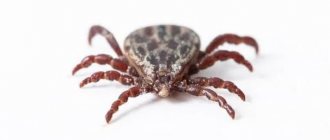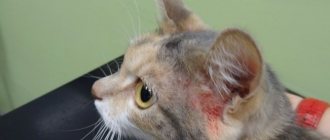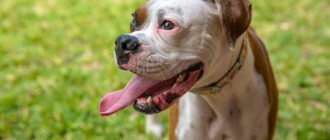Many owners who often travel with animals are familiar with the situation when driving becomes torture due to the fact that the dog gets sick in the car. Many dogs suffer from motion sickness syndrome or kinetosis. At risk are young animals with an immature vestibular apparatus. But for various reasons, adults can also suffer from painful symptoms. If your dog gets sick in the car and you don’t know what to do, then read our article. There are many ways to combat kinetosis along the way. And the sooner this fight begins, the greater the chance that the dog will feel good and the journey will be enjoyable.
How motion sickness occurs
The weakness of the vestibular apparatus lies in the imperfection of the adaptation mechanisms of the central nervous system in the puppy. This is manifested by a mismatch of impulses going to the brain from organs that record changes in the position of the body in space. These are vision, muscles and vestibular apparatus.
The vestibular apparatus is a part of the inner ear that regulates the dog's balance and is responsible for its spatial orientation. Since the vestibular system is connected to the organ of vision, it is important that visual perception corresponds to the signals coming from the vestibular receptors. The information is sent to the brain, which signals the muscles to change body position to restore balance.
Motion sickness is a consequence of the receipt of contradictory information into the brain from the eyes and vestibular receptors during movement (when the eyes record movement and the body is at rest). Spatial orientation is disrupted, the brain provides information about the stressful situation in the body. The autonomic system reacts to this condition with symptoms of a neurological, cardiovascular and digestive nature.
Symptoms of motion sickness
Symptoms of motion sickness resemble signs of severe poisoning of the body or intoxication. This happens because disturbances in the supply of impulses carrying information about the position of the body in space resemble the effect of toxic substances on the brain. The body's protective reaction to both of these conditions is the same.
The main symptoms are:
- severe dizziness;
- nausea and vomiting;
- cardiopalmus;
- increased salivation;
- restlessness (the dog constantly changes body position);
- weakness and lethargy.
Signs of motion sickness and first aid for a pet
During the trip, you must carefully monitor the behavior and appearance of the animal. If discomfort, restlessness, or other changes in behavior are observed, this may indicate that the dog is seasick.
Signs of kinetosis:
- the dog looks depressed, constantly licks its nose and swallows;
- may drool;
- breathing quickens;
- belching and vomiting appear;
- the pet is trembling, unable to sit still, and cannot find a comfortable position.
Only some of these symptoms may be observed, although some animals may exhibit all of them at the same time.
Stuffiness in the car is worst tolerated by breeds with flat noses: bulldogs, pugs, boxers.
If signs of motion sickness appear on the way, you need to stop and provide access to fresh air. If vomiting appears and the interior is dirty, the dog should not be scolded. On the contrary, you need to try to calmly and gently calm him down and give him some water to drink.
If your pet is breathing heavily, it is advisable to place an ice pack on the head between the ears and drop a couple of drops of Corvalol or Valocardin on the tongue. You can give antihistamines: Tavegil, Diphenhydramine. Sleeping pills before travel are not recommended.
Causes of motion sickness
Motion sickness is caused by both medical and behavioral factors.
Medical factors represent various disorders of the vestibular apparatus, as well as some conditions of the body:
- Imperfection of the vestibular apparatus due to young age. In this case, motion sickness torments puppies under the age of 1 year. Then the problem gradually disappears on its own.
- Pathologies of the vestibular system that affect motion sickness include complications after otitis media, traumatic brain injuries, wax plugs in the ears, vestibular neuritis, and tumor diseases of the inner ear.
- Pregnancy. The body experiences special stress during pregnancy, which can also manifest itself as motion sickness in transport.
- Taking certain medications as indicated. This is especially true for drugs used for neurological diseases, some antibiotics and sulfonamides.
Behavioral factors include the following:
- Stressful conditions, fear of a running engine, the smell of gasoline, flickering outside the windows.
- Negative experience of the first trip, if it was associated with an unpleasant event for the dog (visiting a veterinary clinic).
- The motion sickness reflex, which is formed as a result of fear and unpleasant expectations. Nausea can occur already in the cabin, while the car is still standing still.
Adjusting the air pressure inside the machine if the dog is vomiting
The car window must be lowered by 2-5 cm so that more oxygen enters the cabin. In addition, this will balance the air pressure inside the machine and outside. This proven method will help prevent the onset of motion sickness symptoms in both dogs and people.
In most cases, motion sickness goes away with age
Solution
The problem of motion sickness in the car can be solved in several ways, depending on the cause. But in any case, it is better to consult a veterinarian about the most appropriate method of correction in this particular case:
- If your dog gets carsick due to his young age, then you can train his vestibular system by taking him on trips more often. Moreover, the first trips should be short and smooth, not containing sharp turns. With age, the baby’s body will get stronger, and his vestibular apparatus will receive the necessary training.
- The medical problem of motion sickness will be solved after the pet recovers and the vestibular system returns to normal.
- The behavioral problem is solved by changing unpleasant associations from a trip to joyful ones. The situation will be corrected by vacation trips with active games and delicious food. A little treat in the car won't hurt either.
- In all cases, before the trip, you need to prepare the dog’s nervous system with mild sedatives, which must be given two to three days before the trip.
Why does my dog get sick in the car?
The problem of a dog getting motion sickness in a car is related to the characteristics of its vestibular system. Most often, dogs that have not yet turned one year old suffer from motion sickness during the period when their vestibular apparatus is still in the process of strengthening.
If a dog, which has little experience of traveling in a car, does not look out the window (at moving objects) while riding in a car, an imbalance occurs between the brain (it receives information that the dog is driving) and vision (which records static).
How to behave while traveling
In order for the animal’s body to endure the trip as easily as possible, certain conditions must be met to make the dog feel comfortable:
- Remove all irritants: air fresheners in the cabin, loud music.
- Fresh air helps a lot with motion sickness. It is useful to open the windows in the car; you should not smoke on the road.
- It is not recommended to feed your animal nutritiously before traveling. The best option is a light meal a few hours before departure.
- The dog should have a comfortable place. Perhaps it will be easier for her if she sits in her owner’s arms, in the front seat and looks forward as the vehicle moves.
- During a long trip, it is recommended to stop every 1.5-2 hours to give the animal a rest and stretch.
- You should give your pet water often.
- It is important to calm the dog by stroking it and talking to it gently.
- If these measures do not help and your dog gets sick on the road, you can use motion sickness tablets for dogs.
How to reduce discomfort
You can help your pet and reduce his fear of cars in other ways. The same recommendations are usually given to people who have difficulty traveling on public transport:
- feed your pet no later than 5-6 hours before the trip;
- Eliminate strong odors from the interior, remove air flavors, and do not smoke during the trip. It is advisable not to use perfumes or deodorants before traveling;
- maintain silence during the trip - do not play loud music, talk to fellow travelers in a calm, even voice;
- before the trip, walk the dog longer so that it is slightly tired;
- make periodic stops during long trips: give your pet the opportunity to run around and relieve itself.
If possible, choose routes for your trip on roads with smooth surfaces. Bumps and constant shaking provoke nausea not only in animals, but also in people. Avoid sudden jerks and braking, try to drive the car smoothly.
Important!
Take your pet's favorite toy with you on your trip. This will distract him and calm him down.
Drug correction of symptoms
Some medications help improve the condition of the animal in the car. Veterinary pharmacology can offer a whole range of special medications for motion sickness in transport. Having different pharmacological effects, they have a common indication for use - combating motion sickness. The most famous of them are the following drugs:
- Sereniya is an excellent remedy for motion sickness in all types of transport for dogs. This is an antiemetic drug with the active ingredient maropitant citrate. The drug is taken an hour before the trip, is a low-toxic drug, and has the ability to accumulate with repeated use.
- Racefit is an antiemetic drug based on cyclizine hydrochloride, a substance that has an antihistamine and antispasmodic effect. The ability of the hormone histamine to spasm the smooth muscles of the stomach walls is suppressed, which is the cause of vomiting. The drug is not intended for small breed dogs.
- Sanal Relax is a sedative based on the amino acid tryptophan. Reduces nausea and vomiting because it has a sedative effect.
- Avia-sea is a homeopathic remedy for motion sickness for people and dogs. The main pharmacological effect is the stabilization of vestibular disorders. Can be used both for the treatment and prevention of motion sickness. The medicine has virtually no side effects or contraindications.
- Dramamine is an antihistamine drug. The active ingredient, dimenhydrinate, prevents nausea by blocking the production of histamine. Used to correct discomfort when traveling in different types of transport. Used for both dogs and people.
For example:
- Take a break from traveling for a week or two.
- Changing the vehicle to avoid associations with past unpleasant experiences.
- Take short car trips to places your dog enjoys, such as the park.
- Gradually increase your dog's tolerance to car rides; start by training your dog to approach the car, and then spend some time in the car with the engine off. When your dog is ready, take short trips (like around the block) to build up tolerance before moving on to longer car rides.
- Using treats to make the car a fun place for your dog (but be careful not to give too much and make him sick)
- Buying special toys that your dog likes and that he only has access to in the car.
Prevention measures
The best measure to prevent motion sickness for individuals with a weak vestibular apparatus is its training. This can be done in several ways:
- regularly driving a car for short distances without sharp turns and braking;
- walks with active games, and running with a sharp change of direction.
Seasoned active dogs, in good physical shape, accustomed to moving a lot, trained, on duty, used in hunting, as a rule, do not know such a problem as motion sickness in transport.
General recommendations for getting rid of kinetosis
The best way to get rid of kinetosis is to strengthen the vestibular apparatus and vestibular exercises. This means that your pet needs to be transported by car at every opportunity. It's better to start with short periods of time, even if it's just a trip around the house. In addition, you should pay attention to active games with running, sharp turns and jumping. There is an opinion that nimble, active animals have a trained vestibular apparatus, and therefore are less likely to suffer from kinetosis.
Another way to overcome kinetosis is to turn the car into a pleasant place for your pet to stay. To do this, you need to leave your favorite treat, toys or rug here. For the first time, you don’t even have to go anywhere, but simply sit inside the cabin, give the dog time to explore the situation, pet him so that he understands that the car is a place where pleasant events can happen.
In any case, the dog requires the same (and sometimes more) attention during the trip as other passengers. Show her enough care and try to ensure that her stay in the car is as comfortable as possible, so that traveling together leaves only pleasant impressions.











